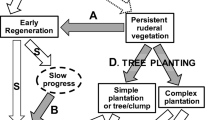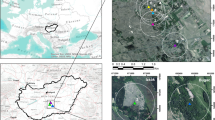Abstract
This study assessed long-term recovery of vegetation on six wilderness campsites in subalpine forests in Oregon that were closed to use and that received common restoration treatments (scarification, soil amendments, mulch, transplanting, and seeding). Vegetation cover was assessed every year for the first 7 years following treatment, as well as 10 and 15 years after treatment. This made it possible to compare long-term treatment effectiveness to short-term efficacy. Plots that were closed and not scarified had virtually no vegetation cover even after 15 years without use. If long-used campsites in these subalpine forests are simply closed and allowed to recover on their own, restoration of undisturbed conditions will require hundreds if not thousands of years. Study results show, however, that simple treatments can accelerate recovery rates substantially. Scarification and transplanting were highly effective treatments, with seeding and soil amendment with organic matter and compost also contributing to success, but to a lesser degree. The use of a mulch mat, in contrast, had no effect, either positive or negative. Assessments of success conducted within the first few years of treatment overestimate treatment efficacy, particularly the effectiveness of soil amendments and seeding.




Similar content being viewed by others
References
Bay RB, Ebersole JJ (2006) Success of turf transplants in restoring alpine trails, Colorado, U.S.A. Arct Antarct Alp Res 38:173–178
Bayfield NG (1980) Replacement of vegetation on disturbed ground near ski lifts in the Cairngorm Mountains, Scotland. J Biogeogr 7:160–249
Brown RW, Johnston RS (1979) Revegetation of disturbed alpine grasslands. In: Johnson DA (ed) Special management needs of alpine ecosystems. Society for Range Management, Denver, pp 76–94
Buckner DL, Marr JW (1990) Use of sodding in alpine revegetation. In: Hughes HG, Bonnicksen TM (eds) Restoration ‘89: the new management challenge. Society for Ecological Restoration, Madison, pp 501–508
Chambers JC (1997) Restoring alpine ecosystems in the western United States: environmental constraints, disturbance characteristics, and restoration success. In: Urbanska KM, Webb NR, Edwards PJ (eds) Restoration ecology and sustainable development. Cambridge University Press, Cambridge, pp 161–187
Chambers JC, MacMahon JA, Brown RW (1990) Alpine seedling establishment: the influence of disturbance type. Ecol 71:1323–1341
Cole DN (2007) Seedling establishment and survival on restored campsites in subalpine forest. Restor Ecol 15:430–439
Cole DN, Fichtler RK (1983) Campsite impact in three western wilderness areas. Environ Manag 7:275–288
Cole DN, Monz CA (2003) Impacts of camping on vegetation: response and recovery following acute and chronic disturbance. Environ Manag 32:693–705
Cole DN, Spildie DR (2006) Restoration of plant cover in subalpine forests disturbed by camping: success of transplanting. Nat Areas J 26:168–178
Cole DN, Spildie DR (2007) Vegetation and soil restoration on highly impacted campsites in the Eagle Cap Wilderness, Oregon. General Technical Report RMRS-GTR-185. USDA Forest Service, Rocky Mountain Research Station, Fort Collins
Conlin DB, Ebersole JJ (2001) Restoration of an alpine disturbance: differential success of species in turf transplants, Colorado, U.S.A. Arct Antarct Alp Res 33:340–347
Deshaies A, Boudreau S, Harper KA (2009) Assisted revegetation in a subarctic environment: effects of fertilization on the performance of three indigenous plant species. Arct Antarct Alp Res 41:434–441
Eriksson O, Fröberg H (1996) “Windows of opportunity” for recruitment in long-lived clonal plants: experimental studies of seedling establishment in Vaccinium shrubs. Can J Bot 74:1369–1374
Fattorini M (2001) Establishment of transplants on machine-graded ski runs above timberline in the Swiss Alps. Restor Ecol 9:119–126
Hitchcock CL, Cronquist A (1973) Flora of the Pacific Northwest. University of Washington Press, Seattle
Johnson CG (2004) Alpine and subalpine vegetation of the Wallowa, Seven Devils and Blue Mountains. USDA Forest Service, Pacific Northwest Region, Portland
Legg M, Farnham K, Miller E (1980) Soil restoration on deteriorated campsites in Texas. South J Appl For 4:189–193
May DE, Webber PJ, May TA (1982) Success of transplanted alpine tundra plants on Niwot Ridge, Colorado. J Appl Ecol 19:965–976
Moritsch BJ, Muir PS (1993) Subalpine revegetation in Yosemite National Park, California: changes in vegetation after three years. Nat Areas J 13:155–163
Paschke MW, DeLeo C, Redente EF (2000) Revegetation of roadcut slopes in Mesa Verde National Park, U.S.A. Restor Ecol 8:276–282
Paschke MW, Topper K, Brobst RB, Redente EF (2005) Long-term effects of biosolids on revegetation of disturbed sagebrush steppe in northwestern Colorado. Restor Ecol 13:545–551
Petersen SL, Roundy BA, Bryant RM (2004) Revegetation methods for high-elevation roadsides at Bryce Canyon National Park, Utah. Restor Ecol 12:248–257
Rowe HI, Brown CS, Paschke MW (2009) The influence of soil inoculums and nitrogen availability on restoration of high-elevation steppe communities invaded by Bromus tectorum. Restor Ecol 17:686–694
Scherrer P, Pickering CM (2006) Recovery of alpine herbfield on a closed walking track in the Kosciuszko alpine zone, Australia. Arct Antarct Alp Res 38:239–248
Smyth CR (1997) Early succession patterns with a native species seed mix on amended and unamended coal mine spoil in the Rocky Mountains of southeastern British Columbia, Canada. Arct Alp Res 29:184–195
Stohlgren TJ, Parsons DJ (1986) Vegetation and soil recovery in wilderness campsites closed to visitor use. Environ Manag 10:375–380
Urbanska KM (1994) Ecological restoration above the timberline: demographic monitoring of whole trial plots in the Swiss Alps. Bot Helv 104:141–156
Urbanska KM, Chambers JC (2002) High-elevation ecosystems. In: Perrow MR, Davy AJ (eds) Handbook of ecological restoration, vol 2., Restoration in practice. Cambridge University Press, Cambridge, pp 376–400
Urbanska KM, Schütz M (1986) Reproduction by seed in alpine plants and revegetation research above timberline. Bot Helv 96:43–60
Willard BE, Marr JW (1971) Recovery of alpine tundra under protection after damage by human activities in the Rocky Mountains of Colorado. Biol Conserv 3:181–190
Willard BE, Cooper DJ, Forbes BC (2007) Natural regeneration of alpine tundra vegetation after human trampling: a 42-year data set from Rocky Mountain National Park, Colorado, USA. Arct Antarct Alp Res 39:177–183
Zabinski CA, DeLuca TH, Cole DN, Moynahan OS (2002) Restoration of highly impacted subalpine campsites in the Eagle Cap Wilderness, Oregon. Restor Ecol 10:275–281
Acknowledgments
Funding and in-kind support for this project were provided by the Forest Service, US Department of Agriculture. I appreciate the field assistance of many Forest Service personnel, particularly Dave Spildie, and the statistical advice of Dave Turner.
Conflict of interest
The author has declared no conflict of interest.
Ethical Standards
Experiments comply with the current laws of the country in which they were performed.
Author information
Authors and Affiliations
Corresponding author
Rights and permissions
About this article
Cite this article
Cole, D.N. Long-Term Effectiveness of Restoration Treatments on Closed Wilderness Campsites. Environmental Management 51, 642–650 (2013). https://doi.org/10.1007/s00267-012-0015-3
Received:
Accepted:
Published:
Issue Date:
DOI: https://doi.org/10.1007/s00267-012-0015-3




